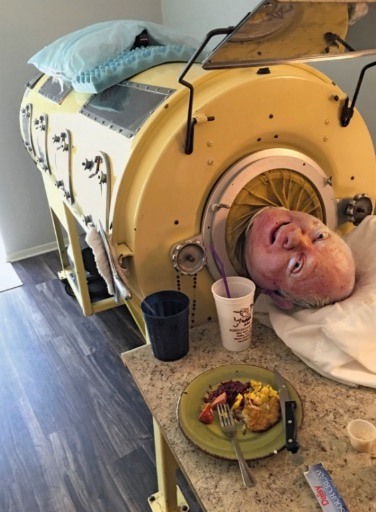Paul Alexander lived a life few could imagine—one marked by extraordinary resilience and determination. For most of his years, Paul resided inside an iron lung, a relic of medical history dating back to 1928. Despite what many would consider insurmountable limitations, Paul lived a life filled with purpose and inspiration. He never let others define what he could or couldn’t do. “I am not going to accept from anybody their limitations on my life. Not gonna do it. My life is incredible,” he once declared.

Paul’s journey began in a Dallas suburb in 1952 when he was just six years old. One day, he ran into his house and told his mother he wasn’t feeling well. Until that moment, Paul had been an active, healthy child. But now, something felt terribly wrong. “Oh my God, not my son,” he recalled his mother saying. Following the doctor’s advice, he rested in bed. But within days, Paul could no longer hold objects, swallow, or breathe on his own. His parents rushed him to the hospital, where he joined a growing number of children suffering from similar symptoms.
At the time, polio was one of the most feared diseases in America. Before vaccines were available, the virus paralyzed over 15,000 people annually. Highly contagious, polio could be transmitted even by individuals who showed no symptoms. Its warning signs included fever, fatigue, vomiting, and muscle stiffness. In severe cases, it could lead to paralysis or even death.
At the hospital, one doctor mistakenly pronounced Paul dead. Luckily, another physician intervened just in time, performing a life-saving emergency tracheotomy and placing him in an iron lung. When Paul regained consciousness three days later, he found himself among rows of children similarly encased in these life-supporting machines. Unable to move or speak due to his tracheotomy, Paul remembered feeling lost and frightened. “I didn’t know what had happened. I had all kinds of imaginings, like I’d died. I kept asking myself: Is this what death is? Is this a coffin?” he recalled.
The iron lung worked by creating negative pressure around the patient’s body, forcing air into the lungs. It was the first machine capable of artificial ventilation. Paul remained in that metal chamber for 18 months, fighting through one of the worst polio epidemics in U.S. history. In 1952 alone, nearly 58,000 people—most of them children—were infected, and over 3,000 lost their lives. “As far as you can see, rows and rows of iron lungs. Full of children,” he later remembered.
Yet Paul never lost his will to survive. He overheard doctors saying he wouldn’t make it, that he was unlikely to live another day. But he was determined to prove them wrong. And he did. In 1954, Paul was released from the hospital, but the world he returned to wasn’t the same. “People didn’t like me very much back then,” he said. “I felt like they were uncomfortable around me.”
With the help of a dedicated therapist named Mrs. Sullivan, Paul began regaining control over his life. She taught him how to “frog-breathe,” a method of drawing air into the lungs by using his tongue and throat muscles. She promised him a puppy if he could breathe independently for three minutes. After months of practice, Paul did just that and gradually began spending more time outside of the iron lung.
At 21, Paul made history as the first student to graduate from a Dallas high school with honors without ever physically attending class. His next goal was college, but he faced repeated rejections. After two years of persistence, Southern Methodist University finally accepted him under two conditions: he had to receive the polio vaccine, and a fraternity had to assume responsibility for assisting him. Paul not only attended but went on to law school at the University of Texas at Austin. He passed the bar and became a practicing attorney in the Dallas-Fort Worth area. “And I was a pretty damn good one too!” he proudly said.
Even after a successful 30-year legal career, Paul didn’t slow down. He wrote a book by typing with a pen strapped to a stick, a testament to his ingenuity and perseverance. By that time, he was one of the last known people still using an iron lung. While more modern ventilators existed, Paul preferred his traditional metal chamber. He even traveled with it, bringing it along to college and living in a dorm. “That freaked everybody out,” he joked.
In 2017, when his iron lung began to fail, Paul made a public plea on YouTube for help. Fortunately, old machines and spare parts were still scattered around the country. Enthusiasts of vintage technology stepped up, helping Paul keep his beloved device running. “I’ve found them in barns, garages, junk shops—not much, but enough to scrounge parts,” he said.
Paul often credited his fulfilling life to one core belief: never give up. “I wanted to accomplish the things I was told I couldn’t accomplish,” he said, “and to achieve the dreams I dreamed.” Though polio has been eradicated in the U.S. since 1979, his story remains a powerful reminder of the human spirit’s strength.
Paul Alexander passed away in March 2024, remembered not for the machine that kept him alive, but for the life he built despite it. His brother Philip spoke of Paul’s warmth, resilience, and infectious smile. “To me, he was just a normal brother,” Philip said. “We fought, we played, we loved, we partied, we went to concerts together.” Paul lived on his own terms, mastering his environment and refusing to be defined by his condition.
He leaves behind a legacy that will continue to inspire. His life is proof that limitations are often only in the mind—and that with enough courage and persistence, anything is possible.





